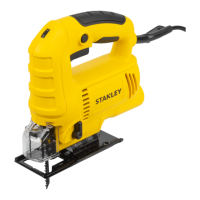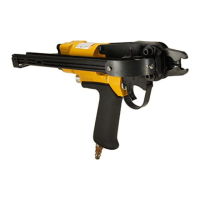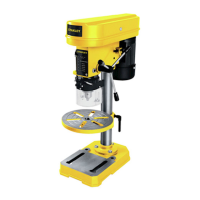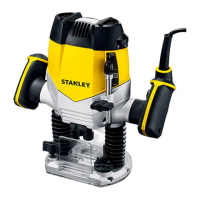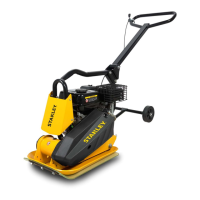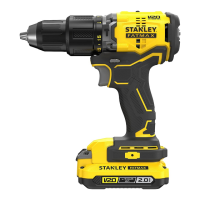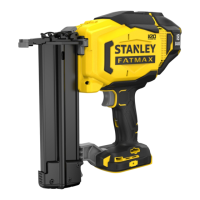ENGLISH (Original Instructions)
20
f. Keep cutting tools sharp and clean. Properly
maintained cutting tools with sharp cutting edges are
less likely to bind and are easier to control.
g. Use the power tool, accessories and tool bits etc.
in accordance with these instructions, taking into
account the working conditions and the work to
be performed. Use of the power tool for operations
different from those intended could result in a hazardous
situation.
5. Power tool use and care
a. Do not force the power tool. Use the correct power
tool for your application. The correct power tool will
do the job better and safer at the rate for which it was
designed.
b. Do not use the power tool if the switch does not
turn it on and off. Any power tool that cannot be
controlled with the switch is dangerous and must be
repaired.
c. Disconnect the plug from the power source and/
or the battery pack from the power tool before
making any adjustments, changing accessories,
or storing power tools. Such preventive safety
measures reduce the risk of starting the power tool
accidentally.
d. Store idle power tools out of the reach of children
and do not allow persons unfamiliar with the
power tool or these instructions to operate the
power tool. Power tools are dangerous in the hands
of untrained users.
6. Service
a. Have your power tool serviced by a qualified
repair person using only identical replacement
parts. This will ensure that the safety of the power tool
is maintained.
ADDITIONAL SPECIFIC SAFETY RULES
Safety Instructions for Jigsaw
a. Hold power tools by insulated gripping surfaces,
when performing an operation where the cutting
accessory may contact hidden wiring or its own
cord. Cutting accessory contacting a “live” wire may
make exposed metal parts of the power tool “live” and
could give the opertator an electric shock.
b. Use clamps or another practical way to secure
and support the work piece to a stable platform.
Holding the work by hand or against your body leaves it
unstable and may lead to loss of control.
c. Keep hands away from cutting area.Never reach
underneath the material for any reason. Hold front
of saw by grasping the contoured gripping area.
Do not insert fingers or thumb into the vicinity of the
reciprocating blade and blade clamp. Do not stabilize
the saw by gripping the shoe.
d. Keep blades sharp. Dull blades may cause the saw to
swerve or stall under pressure.
e. When cutting pipe or conduit ensure that they are
free from water, electrical wiring, etc.
f. Allow the motor to come to a complete stop before
withdrawing the blade from the kerf (the slot
created by cutting). A moving blade may impact the
workpiece causing a broken blade, workpiece damage
or loss of control and possible personal injury.
g. Do not touch the workpiece or the blade
immediately after operating the tool. They can
become very hot.
h. Keep handles dry, clean, free from oil and grease.
This will enable better control of the tool.
i. Clean out your tool often, especially after heavy
use. Dust and grit containing metal particles often
accumulate on interior surfaces and could create an
electric shock hazard.
j. Do not operate this tool for long periods of time.
Vibration caused by the operating action of this tool may
cause permanent injury to fingers, hands, and arms.
Use gloves to provide extra cushion, take frequent rest
periods, and limit daily time of use.
k. Avoid prolonged contact with dust from sawing
activities. Wear protective clothing and wash
exposed areas with soap and water. Allowing dust
to get into your mouth, eyes, or lay on the skin may
promote absorption of harmful chemicals.
l. Avoid cutting nails. Inspect workpiece for any nails
and remove them before operation.
m. Do not cut oversize workpiece.
n. Make sure the blade is not contacting the
workpiece before the switch in turned on.
o. Do not leave the tool running. Operate the tool only
when hand held.
p. Some material contains chemicals witch may be
toxic. Take caution to prevent dust inhalation and skin
contact. Follow material supplier safety data.
q. Always switch off and wait for the blade to come to
complete stop before removing the blade from the
workpiece. Use clamps or another practical way
to secure and support the workpiece to a stable
platform. Holding the work by hand or against your
body leaves it unstable and may lead to loss of control.
SAFETY OF OTHERS
♦ This appliance is not intended for use by persons
(including children) with reduced physical, sensory
or mental capabilities, or lack of experience and
knowledge, unless they have been given supervision or
instruction concerning use of the appliance by a person
responsible for their safety.
♦ Children should be supervised to ensure that they do
not play with the appliance.
RESIDUAL RISKS
Additional Safety Information
WARNING! We recommend the use of a residual
current device with a residual current rating of
30mA or less.
In spite of the application of the relevant safety regulations
and the implementation of safety devices, certain residual
risks cannot be avoided. These are:
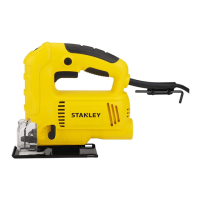
